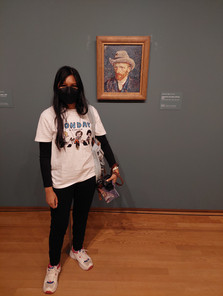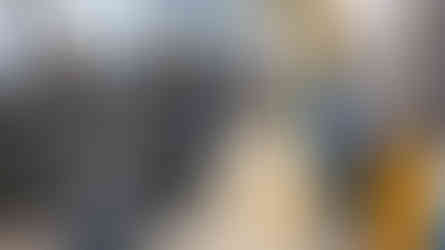Amsterdam, the Land of Dancing Houses
- ILICarrieDoll

- Dec 18, 2021
- 14 min read
Updated: Dec 30, 2021
One of my bucketlist is to visit Europe. I had been to many places due to my father's job (and even mine) but they're mainly in Asia. So far the 'Western' countries I had been is the US when I was a baby and New Zealand in 2015 with my friends.

When Malaysia announced they're lifting travel ban (both local and international) on October 11th 2021, I knew I must plan my travel asap to see Domagoj again. We went through many research and discovered only nine European countries accepting Sinovac (plus no quarantine needed). We finally decided to meet up at one of my European bucket list places to visit: Amsterdam.
This entry is solely about places I visited in Amsterdam. Other places such as Rotterdam, Volendam, as well as some personal stories will be in different entries in the future.
Amsterdam Airport Schiphol
After nearly 15 hours flight (with 3 hours stop at Doha, Qatar), I can't believe I'm finally in Europe! I'm finally in Amsterdam! The lady sat next to me Maryam noticed rainbow over the field and we both excited thinking Amsterdam is welcoming us! (This is her first trip to Europe too! Also thanking her for helping me snapping this amazing rainbow shot).
I admit I find the airport to be quite old school because I'm too used to Kuala Lumpur Internationa Airport (KLIA) where the design and facilities are really modern. Still find it funny to find Schiphol looks old school considering the airport is the Netherlands' busiest airport as well as the third busiest in Europe and 11th busiest airport in the world.
Amsterdam Airport Schiphol, known informally as Schiphol Airport, is the main international airport of the Netherlands. It is located 9 kilometres southwest of Amsterdam, in the municipality of Haarlemmermeer in the province of North Holland.

I had always wondered where this famous "I Amsterdam" landmark is, turned out it's just outside the airport haha!
Rijksmuseum
Ah the famous Rijksmuseum! I admit while doing research in Amsterdam I have no plan to visit Rijksmuseum but it seems this is a must place to visit, especially if you're an art (or history) student/enthusiast. Plus my friend Zabeda been poking me to visit this place.
Too bad the Rijkmuseum garden (located on Museumplein side) is temporarily closed.
The Rijksmuseum (English: National Museum) is a Dutch national museum[10] dedicated to arts and history in Amsterdam. The museum is located at the Museum Square in the borough Amsterdam South, close to the Van Gogh Museum, the Stedelijk Museum Amsterdam, and the Concertgebouw.
The Rijksmuseum was founded in The Hague on 19 November 1798 and moved to Amsterdam in 1808, where it was first located in the Royal Palace and later in the Trippenhuis. It is also the largest art museum in the country.
The museum has on display 8,000 objects of art and history, from their total collection of 1 million objects from the years 1200–2000, among which are some masterpieces by Rembrandt, Frans Hals, and Johannes Vermeer. The museum also has a small Asian collection, which is on display in the Asian pavilion.
And of course the famous Militia Company of District II under the Command of Captain Frans Banninck Cocq, also known as The Shooting Company of Frans Banning Cocq and Willem van Ruytenburch, but commonly referred to as The Night Watch (Dutch: De Nachtwacht), is a 1642 painting by Rembrandt van Rijn.
It is in the collection of the Amsterdam Museum but is prominently displayed in the Rijksmuseum as the best-known painting in its collection. The Night Watch is one of the most famous Dutch Golden Age paintings.
The painting is famous for three things: its colossal size (363 cm × 437 cm (11.91 ft × 14.34 ft)), the dramatic use of light and shadow (tenebrism) and the perception of motion in what would have traditionally been a static military group portrait.
Not goonna lie, the art student/enthusiast in me can't help but to squealing internally!
Canal Cruise
We originally wanted to take the canal cruise on the first three days but due to the constant rain, we only managed to do o the fifth day. Again similar to Rijksmuseum, I originally plan to skip the canal cruise but everyone encouraged us to have one so here we go.
I admit I thought the cruise is just, well cruising around the canal. While this is still true, but it also served as history lessons and a tour around Amsterdam. By the end of the day, Domagoj said now he knows why almost everyone do the canal cruise on the first two days, to get to know all the places to visit and I agree, I wished we did this sooner.
When we first arrived Amsterdam, Domagoj took noticed that some houses leaned a bit and had been wondering about it. I also joked that some houses looked like a face which I find them funny because some of them looked like they were screaming out of fear.
During the cruise we learnt that both Domagoj and I were right with our observations.
It all started how Amsterdam was founded; Amsterdam was founded as a fishing village around the thirteenth century, developing round a dam in the Amstel river at the end of the 12th century. All houses in Amsterdam are built on piles. The piles are drilled meters deep into the wet soil. If you build houses without a sturdy pole, it will quickly sink into the swampy ground. In many cases, the quality of the wood was not good enough to withstand centuries. Save to say, the builders did not give out a three hundred year guarantee! The old age and quality of the wooden piles make the buildings in Amsterdam sink unevenly in the ground, making the buildings in Amsterdam looked skewed.
The houses along the canals in Amsterdam lean on each other for extra stability. Problems arise when one house in the row is renovated. When the poles are not in the best condition, the houses next door will start to lean to one side. In many cases, houses in Amsterdam seem to lean forward, towards the street. This is not an accident. For centuries, it was custom to build houses leaning forward.
Over the years people starting to become creative so they begin to purposely designed their houses by strategically placing the windows and the doors in a way to resemble a face. Because of this and with their leaning positions, these canal houses (grachtenpand) are also called the 'dancing houses'.

One thing Domagoj pointed to me is the hooks on the top of each building. According to Domagoj, because the houses in some parts of Europe have narrow, steep, often winding staircases that make it difficult to bring large, bulky objects upstairs. The hook is there to enable residents to pull large, bulky objects up and into a window at the proper floor.
As for Amsterdam, most of the houses in Amsterdam were not used just for living. They were also used to store goods. Amsterdam was a typical ‘staple port’. This is a place where merchants make money by trading all kinds of goods that enter into the city, usually by boat. The goods were hoisted up from the street using the hook on the beam sticking out at the top floor.
A leaning facade meant it was less likely that the goods hit the wall or break a window.

Now one of the highlights of the cruise, the House with the Heads (known as 'Huis met de Hoofden' in Dutch) is a large canal house on the Keizersgracht 123 in Amsterdam, named after the six ornaments shaped as heads, which are on the facade. We were first told that the ornaments are said to be images of six Roman gods: Apollo with the laurel wreath (the arts); Ceres with the grain (agriculture); Mercury with the winged helmet (trade); Minerva (wisdom); Bacchus with the grapes (wine); and Diana with the half moon (hunt). THEN, we were told of another story; there is a legend that they refer to six thieves who had tried to break in the house and were then beheaded by the maid. Me only reaction when being told the second story, "Boy, that's escalates quickly!"

And finally, the main highlight of the cruise, the "Seven Bridges Amsterdam" in Reguliersgrach. The cruise slowed down to give everyone the chance to snap photo of the seven bridges perfectly aligned. The Reguliersgracht canal passes through the Herengracht, Keizersgracht & Prinsengracht canals. As a result, these points are great places to admire the bridges and canal boats passing by.
Conclusion, if anyone visiting Amsterdam, please take the canal cruise on the first two days. Trust me it's very helpful to give you insight of places to visit as well as helping you to get the city navigation.
The Rembrandt House Museum
Ok as a former art student (and till an art enthusiast) in me is screaming internally. I really loves Rembrandt works (still over the moon seeing his masterpieces in Rijksmuseum earlier) and to think of visiting his -real- house is so surreal!
The Rembrandt House Museum (Dutch: Museum Het Rembrandthuis) is a historic house and art museum in Amsterdam in the Netherlands. Painter Rembrandt lived and worked in the house between 1639 and 1656. The 17th-century interior has been reconstructed. The collection contains Rembrandt's etchings and paintings of his contemporaries.
The house is located in the Jodenbreestraat in Amsterdam, where Rembrandt lived and painted for a number of years, not far from the present-day city hall.
One thing I learnt from this visit that the people in the old days were quite small as evident as many doors in the house. Even I taller than the doors! And Domagoj had been calling me small and short. Another thing I learnt is the existence of box-bed. A box-bed is a bed enclosed in furniture that looks like a cupboard, half-opened or not. The form originates in western European late medieval furniture. This is because they believe lying down was associated with death, and therefore sleeping was done in a half-upright position.
The kids section. I know I'm an adult but I still wanna play! I just can't resist puzzles!
Important note, if you just want to see Rembrandt's painting works, you better go to Rijksmuseum instead. The Rembrandt House Museum didn't display his works, but instead gave more insight of his life and the life of the Dutch in general in the 16th century.
Van Gogh Mesuem
Finally the museum I really want to visit from the start, Van Gogh! Van Gogh works and life were heavily studied during my years studying art, from high school to university.
The Van Gogh Museum is a Dutch art museum dedicated to the works of Vincent van Gogh and his contemporaries in the Museum Square in Amsterdam South, close to the Stedelijk Museum, the Rijksmuseum, and the Concertgebouw. The museum contains the largest collection of Van Gogh's paintings and drawings in the world.
Admittedly after the Rijksmuseum and Rembrandt house, I find the Van Gogh museum to be less interesting even tho this is the first place I planned to visit.
Anne Frank's House
One of the places a must-visit-in-Amsterdam is Anne Frank house. However both Domagoj and I were not interested so we just decided to take photos from the outside.
The Anne Frank House (Anne Frank Huis) is a writer's house and biographical museum dedicated to Jewish wartime diarist Anne Frank. The building is located on a canal called the Prinsengracht, close to the Westerkerk, in central Amsterdam in the Netherlands.
Tulip Museum
One of of our unplanned visit is the Amsterdam Tulip Museum that situated two mins away from Anne Frank House. To be honest we think the place is very small and not actually a museum but we decided to give it a try and I'm sure glad we did!
Divided into six sections, the Amsterdam Tulip Museum tells about the history of the tulip. From the origin of the tulip in Central Asia, to the Tulip Mania, to cultivation and modern hybridization in the Netherlands.
We were pleasantly surprised to learnt how intensive the tulip history and any tulip related covered here. On the top of the museum is the Flower Bulb Shop where they sell tulip related items; ranging from the real tulip bulbs to tulip shapes/themes items.
Conclusion, even tho the Amsterdam Tulip Museum is not in the must-visit-place in Amsterdam, I suggest you give it a try, especially if you're a plant enthusiast.
Madame Tussaud Amsterdam
On the seventh day we decided to meet up with Wilma and I'm very thankful she said she could come over to Amsterdam instead of us going to her (we both still unfamiliar with the public transportation). During the chit chat I suggested us to go to Madame Tussauds since that place had been in one of my bucket list so here we go!

Madame Tussauds Amsterdam is a wax museum situated in Amsterdam, the capital city of the Netherlands. It is located in the centre of the city on Dam Square, near the Royal Palace of Amsterdam. Founded in 1970, it was the first Madame Tussauds that was opened in mainland Europe as well as being the first foreign branch of the British institution. The collection of Madame Tussauds Amsterdam consists of a collection of wax figures of famous celebrities in different categories such as the Golden Age of Dutch history, music, sport & movie.
[Part 1: Red Carpet (entry) and Personalities of Cinema]
[Part 2: Personalities in the Fashion and Music Industry:] the Dutch darling Nikki Tutorials!
[Part 3: Personalities of the Royal Family and World Leaders]
[Part 4: Personalities in art, science and culture] Domagoj taking his second shot with Einstein after he did one in London. As for me I had lots of funs with some of the 'artists'.
[Part 5: Marvel Superheroes] To be honest, this is one is pretty cool.
I didn't know I was very excited until I overheard Domagoj telling Wilma he didn't expect me to be this enthusiastic. Domagoj initially thinking of skipping Madame Tussaude as he taught they focused more on local Dutch celebs which may be unfamiliar with both of us.
Random Things to Look For in Amsterdam!
While I highlighted all the main (must-visit) places I had visited, there are some small activities I did I would recommended others to try as well. For NSFW experiences (both museums and shops I wrote in a separate entry).
Wau Malaysian Restuarant
As any Malaysian will tell you, you need to go find any Malaysian related things while in overseas and in this case we discovered a Malaysian restaurant nearby our hotel.
Putting aside the pricey price (even for local standard!), the taste is very authentic! The chef is from Burma and the owner/founder/part-time chef is a man from China who married a Malaysian woman.
The Mannekenpis Fries!
Zabeda been hyping me that I need to try this Mannekenpis fries (the famous one is at Damrak 41) and she told me that the queue is very long and my god she wasn't joking! We were lucky we found another branch (at Nieuwendijk 222) that for some reason not many people queuing and we had been frequent there during our stay. We are totally obsessed with their Amsterdam Onion Sauce that we refused to try other sauces (we did try truffle mayonnaise sauce at one point but Domagoj is not a fan)!
I did tell Domagoj that the name sounds like a piss. Well, turned out I wasn't wrong! The brand name (and logo) came from Manneken Pis (Dutch for 'Little Pissing Man') is a landmark 61 cm (24 in) bronze fountain sculpture in central Brussels, Belgium, depicting a puer mingens or naked little boy urinating into the fountain's basin. Manneken Pis is one of the best-known symbols of Brussels and Belgium. It is also an example of belgitude (French; lit.'Belgianness'), as well as of folk humour (zwanze) popular in Brussels.
One of the rare days where we have to queue at Nieuwendijk 222 branch. It's worth it tho.
Berlinerbollen at Rembrandtplein
One of unplanned things for us is to get berlinerbolle at Rembrandtplein. We were casually walking when we saw people gathering here so we decided to give it a try. I got myself the standard vanilla crème while Domagoj decided to try strawberry and banana. The strawberry and banana comes with the actual fruit pieces but we find them too sweet!
In case you're curious, a Berliner is a German doughnut with no central hole, made from sweet yeast doughfried in fat or oil, with a marmalade or jam filling like a jelly doughnut, and usually icing, powdered sugar or conventional sugar on top. They are sometimes made with chocolate, champagne, pastry cream or crème patissière, mocha, or advocaat filling, or with no filling at all.
Bloemenmarket, the Floating Tulip Market
I passed this place several times and even tho I was interested to buy some of the seeds, I was quite unsure with the Malaysian custom law so I decided not to get any.
The Bloemenmarkt is the world's only floating flower market. Founded in 1862, it is sited in Amsterdam, Netherlands, on the Singel canal between Muntplein and Koningsplein in the city's southern canal belt. It has 15 souvenir and gift shops, with only a few still selling fresh flowers. Today the market is one of the main supplier of flower bulbs and tulip paraphernalis to tourists visiting Amsterdam.
Flower Bike Man
Domagoj and I noticed several beautiful flower bike installments throughout Amsterdam and took photos with some of them (the one we took together is 5-mins walk from Rijkmuseum). Little did we know the beautiful story behinds it.
The colourful crusader putting smiles on the faces of residents and visitors is known locally as the Flower Bike Man. Warren Gregory (50), originally from Florida, has created over 300 flamboyantly decorated bicycles, many chained around the city, adding a welcome pop of colour irresistible to photographers. read more story of this wonderful man here.
Bijenkorf
There's nothing particular with De Bijenkorf but since it located next to our hotel, we might as well have a look at it. Honestly it's a very typical (semi-luxurious) mall.
De Bijenkorf (literally, "the beehive") is a chain of high-end department stores in the Netherlands, with its flagship store on Dam Square in Amsterdam. The chain is owned by the Weston family, which also owns Britain's Selfridges, Canada's Holt Renfrew and Ireland's Brown Thomas and Arnotts.
But the one I truly enjoyed is the automatons in the mall! They're simply amazing!
The Flea Markets!
For those who knows me knows how much I love flea markets. I discovered this flea market during the canal cruise. Located just behind Rembrandt House Museum, Waterlooplein Market at the Waterloo Square is not only the oldest flea market of Amsterdam but also in the Netherlands. One hundred and thirty-tree years ago established, six days a week and about three hundred stalls, one of the nicest and friendliest places in the heart of Amsterdam. You can unlimited wander, look and possibly buy. Vintage cameras, to used books, to jewelry and the latest fashion for little.
Afterwards as we walked passed Anne Frank House, Domagoj noticed groups of vans and trucks so we decided to head towards it and lo and behold, another market! I found out from one of the stalls that this market only opens on Saturdays so we were very lucky!
On Saturdays, three connected markets take place on the northwestern banks of Prinsengracht Canal on a triangular plaza that surrounds a 17th-century church called Noorderkerk. These markets have essentially merged into one bumper-sized event known as Noordermarkt, which always features an enormous selection of high-quality organic food, freshly-made street bites and second-hand knick-knacks. The market serves as an important hub for local gourmet food vendors and includes stalls that sell hard-to-find culinary staples like freshly-picked mushrooms and seasonal cheese.
*singing mode* Going through the crowd during the rain, during the rain, during the rain.
Amsterdam in General
One thing I didn't expect of The Netherlands is it's rotting weather! I had grown up being told of the English rotten weather but now I know The Netherlands during late autumn to winter is roughly the same. Or as some locals claimed it's a lot more worst lol.
The famous the Waag ("weigh house"), the Waag is a 15th-century building on Nieuwmarkt square in Amsterdam. It was originally a city gate and part of the walls of Amsterdam. Later it served as a guildhall, museum, fire station and anatomical theatre, among other things. The Waag is the oldest remaining non-religious building in Amsterdam. The building was listed as a national monument (rijksmonument) in 1970.
Typical cloudy/raining, no sun day in Amsterdam. From Zeedijk to Dam Square.
One of the rare times we actually sees the sun, nearby Rijkmuseum (Zieseniskade) XD
Landmarks! Landmarks! Statue! Statues! All need to be taken photos with!
We stumbled the Amsterdam City Archieve while walking to Rijksmuseum.
Finally riding a tram! Domagoj wasn't so enthusiastic about it as tram is very common in Europe but for me this is a new experience as I never ride a tram! We don't have tram in Malaysia (well we do actually. The sole tram service in present-day Malaysia operated in George Town, Penang in British Malaya between 1906 and 1936; its service was discontinued in favor of trolleybuses - which would in turn be replaced by conventional diesel buses).
I still find it surreal to have something like a train moving on the same level, on the same streets with other vehicles and people! I don't know, I find it dangerous haha.
Taking a ride from Leidseplein to Nieuwezijds Kolk. Finally my feet can rest!
Breathtaking Night View
One of the reasons we chosen Amsterdam as point to meet because at the time we were making preparations The Netherlands was one of the relaxing countries when it comes to Covid law. Little did we know just days before arrive they decided to lockdown. Everything closed at 8pm. Even tho the night begin at 5pm, we still missing out many night activities.

Just as when you thing things could go worse it did. Only after three days arriving, they decided to extended the lockdown further, now everything close at 5pm! So rather than enjoying Amsterdam night life, we spend night time walking around the nearly empty city.
Luckily the lighting are beautiful and one time we were lucky to stumble upon Christmas tree market at the Waag. Laugh at me but we don't have these kind of things in Malaysia so it was something new to me.
Regardless the whole experience had been amazing and I do hope one day I can visit more European countries.

















































































































































































































































































































































































































































































Comments